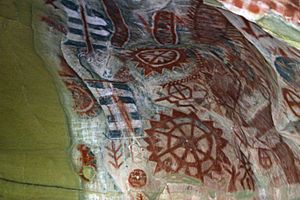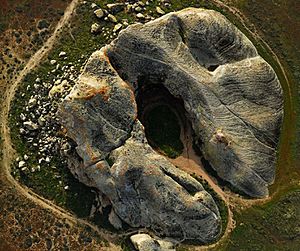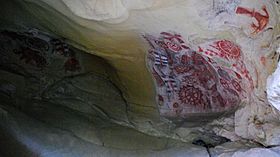Rock art of the Chumash people facts for kids
Chumash rock art is amazing artwork painted by the Chumash people of Southern California. These paintings are found on caves, mountains, and cliffs. The Chumash created two main types of rock art: pictographs (paintings) and petroglyphs (carvings). This art tradition was very active until the 1800s. Many people think Chumash rock art is some of the most detailed and beautiful in the area.
The Chumash are famous for their pictographs. These were bright paintings of people, animals, and cool abstract shapes. People believe these paintings were part of important religious ceremonies.
Contents
Who Were the Chumash People?
The Chumash people lived in what is now Santa Barbara, Ventura, and San Luis Obispo counties in Southern California. They lived there for about 14,000 years! They were a hunter-gatherer society. This means they hunted animals and gathered plants for food. They were also very skilled at fishing. They caught fish, shellfish, and other sea animals.
Besides being great fishers, the Chumash were also talented artists. Rock art is a way to show important ideas and things using symbols. These symbols are painted or carved onto rock surfaces. Shamans, who were spiritual leaders, might have created this art. They often made it during special spiritual journeys called vision quests. Most of the art is pictographs (paintings), but some are petroglyphs (carvings). We don't know the exact meaning of all Chumash rock art. But experts believe it is connected to their religion and how they understood the stars.
Where to Find Chumash Art
You can almost always find Chumash rock art in caves or on cliffs in the mountains. Sometimes, small painted rocks have also been found. These rock art sites are always close to water sources. This could be a stream, a spring, or another place with water.
One researcher, Campbell Grant, studied many sites. He found that all of them were near water. He recorded twelve painted sites in the mountains of the Ventureño area. The Ventura and Santa Clara Rivers flow through this region. He also found 41 painted sites in the Cuyama Valley. The Sisquoc River flows between the San Rafael and Sierra Madre Mountains there.
The easiest place to visit is Painted Cave State Historic Park. It is located in the canyons above Santa Barbara.
Famous Chumash Art Locations
- Painted Rock: This is a large, free-standing rock. It is found on the Carrizo Plain near the Sierra Madre Mountains. Inside this horseshoe-shaped rock, you can see pictographs. These were made by Chumash, other tribes, and even non-Native Americans.
- Burro Flats Painted Cave: These carvings are in the Simi Hills in Ventura County. They are on private land. This has helped protect them since 1947. The land is now being cleaned up. The people in charge are working to protect these important Chumash sites during the cleanup.
Meaning Behind the Art
Chumash stories say that special religious leaders created the rock art. These leaders were called alchuklash. Other people sometimes called them medicine men or shamans.
A shaman is a spiritual leader. They connect directly with the spirit world. In Chumash lands, places for vision quests were often near the shaman's village. The Chumash believed caves, rocks, and water sources were very powerful. Shamans saw them as "portals to the sacred realm." This meant they were places where they could enter the spirit world.
Shamans would enter a special altered state of consciousness. In this state, they would receive visions. They also gained supernatural power from spirit helpers. These helpers often appeared as strong and sometimes dangerous animals. Examples include rattlesnakes and grizzly bears. Spirit helpers almost never looked like animals that were important food sources. This was because it was considered wrong for a shaman to eat meat from their helper's animal.
Art Materials and Styles
Chumash rock art shows images of people, animals, and stars. It also has many different shapes and patterns. These pictures vary a lot. They don't seem to be in any special order. The colors also change. Some paintings use only one color (monochromes), like different shades of red or black. Others use many different colors (polychromes).
The Chumash made their paint from natural materials. They mixed mineralized soil and ground-up stone. They added a liquid binder, like animal blood or oil, or mashed seeds. Adding oil helped the paint last a long time and made it waterproof.
- Orange and red paint came from hematite or iron oxide.
- Yellow paint came from limonite.
- Blue and green paint came from copper or serpentine.
- White paint came from kaolin clay or gypsum.
- Black paint came from manganese or charcoal.
Artists applied the paint with their fingers or with a brush. The images can be grouped into two types: representational and abstract. Representational images look like real things. Abstract images are shapes and patterns. These include squares, circles, triangles, zigzags, and parallel lines. In settled villages, abstract paintings were more common. In areas where hunting groups lived, representational images were seen more often.
Tree Carvings: Arborglyphs
In 2006, something special was found on an oak tree. It was in the Santa Lucia Range in San Luis Obispo County. This carving, called an arborglyph, was Chumash art! People first thought cowboys made the "scorpion tree." But archaeologists now believe it is the only known Native American arborglyph in the western United States. Experts think the carving on the tree might show the movement of stars and planets. If this is true, it means Chumash art was also used as a type of astronomical calendar.
How Old is the Art?
It's hard to know exactly how old all the paintings are. But a radiocarbon test was done on paint from a Santa Barbara area pictograph. This test showed that the sample was "not over 2,000 years old." This means some of the art is very ancient!





